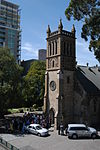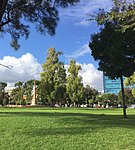Hindley Street

Hindley Street is located in the north-west quarter of the centre of Adelaide, the capital of South Australia. It runs between King William Street and West Terrace. The street was named after Charles Hindley, a British parliamentarian and social reformist. The street was one of the first built in Adelaide and is thus of historical significance. The first newspaper in South Australia was printed in premises on Hindley Street. As well as housing the first meeting of Adelaide City Council, the oldest municipal body in Australia, Hindley Street was home to the first stone church in South Australia and the West End Brewery between 1859 and 1980. The street later became known for its atmosphere and active nightlife, including a somewhat seedy reputation, until in the 21st century it reinvented itself as a more upmarket precinct, dubbed the West End.
Excerpt from the Wikipedia article Hindley Street (License: CC BY-SA 3.0, Authors, Images).Hindley Street
Hindley Street, Adelaide Adelaide
Geographical coordinates (GPS) Address Nearby Places Show on map
Geographical coordinates (GPS)
| Latitude | Longitude |
|---|---|
| N -34.9233 ° | E 138.5941 ° |
Address
Hindley Street 128
5000 Adelaide, Adelaide
South Australia, Australia
Open on Google Maps




